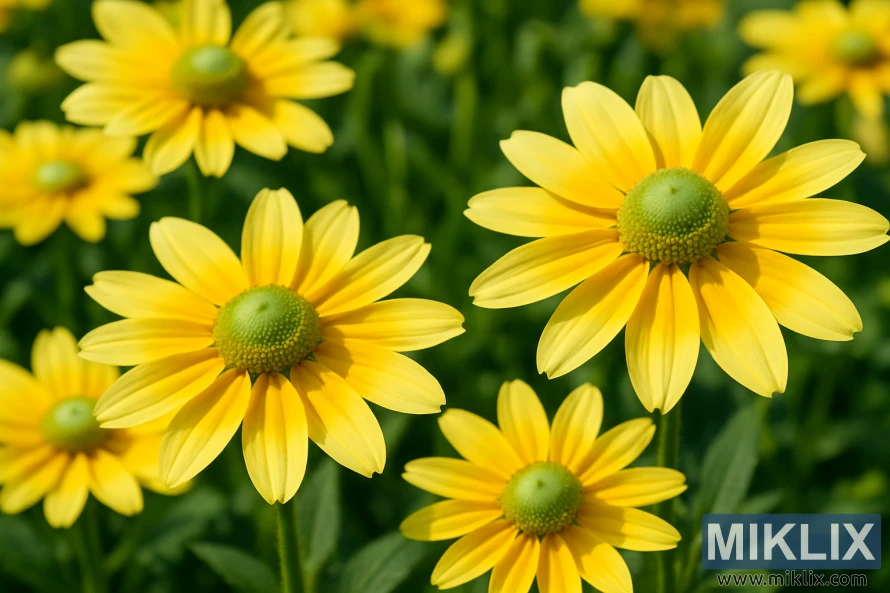Image: Rudbeckia ‘Prairie Sun’ — Yellow Rays, Green Eye
Published: October 27, 2025 at 9:10:27 PM UTC
High-resolution landscape close-up of Rudbeckia ‘Prairie Sun’ showing yellow petals with lighter tips and a distinctive green center, glowing in bright summer light against a soft green backdrop.
This high-resolution, landscape photograph offers a luminous close-up of Rudbeckia ‘Prairie Sun’, a selection renowned for its cheerful bicolor rays and distinctive green central cone. The frame is filled with open daisylike blooms, their petals arranged in crisp radial order around centers that glow a fresh chartreuse. Sunlight from a bright summer day pours across the scene, intensifying the clear yellows while leaving a cool, minty cast over the domed disks. The overall effect is buoyant and airy, as if the flowers were small suns suspended above a meadow of soft green.
In the foreground, three primary blossoms dominate the plane of focus. Each flower presents a circle of smooth, slightly overlapping petals—broad at the base, narrowing gently toward rounded tips. A hallmark of ‘Prairie Sun’ is the lighter, almost lemon-cream edging along those tips, and here that feature reads like a delicate halo. The tonal shift is subtle but persistent: a warm butter yellow at mid-petal feathering into pale, near-translucent ends that catch and scatter the light. Fine longitudinal striations run the length of the rays, barely raised, giving the surface a satin texture that reflects the sun in thin, linear gleams.
The central cones are vividly articulated. Rather than the black or chocolate brown typical of many coneflowers, these are a bright, grassy green, built from countless tiny, tightly packed disk florets. At close range the cone’s micro-structure appears as a patterned grid—minute domes and dimples—so that highlights sparkle across it like dew. Toward the very center the color deepens to a mellow olive; toward the outer ring it shifts yellow-green where the youngest florets meet the base of the rays. This cool core heightens the color contrast with the warm petals and anchors the composition with a crisp focal point.
A shallow depth of field gently releases the rest of the garden into a soft bokeh. Behind the focused trio, more flowers hover as bright disks—recognizable as Rudbeckia by their silhouette but blurred enough to read as atmosphere. The foliage is a velvety, mid-toned green: oblong to lanceolate leaves with faint serrations, lightly pubescent along the margins. Stems read as sturdy yet graceful, lifting the blooms just above the leaf mass so the rays can fully occupy the light. The blurred background suggests a wide, thriving planting: repeating rhythms of yellow circles flickering in and out of focus, like sunlit reflections on water.
Light is the quiet engine of the image. It skims the upper petals, creating luminous bands and soft shadows between overlaps that give the corollas a subtle, bowl-like volume. Where the rays angle toward the camera, the lighter tips seem to glow, their edges outlined by a hairline of brilliance. The cones, by contrast, gather the light and redistribute it in tiny highlights. Nothing looks harsh; the sun feels generous, the air clear and still.
The photograph captures the character that makes ‘Prairie Sun’ beloved: spirited but refined, bright yet cooling, with the unique green eye that keeps the composition fresh. It communicates not just botanical detail—petal gradations, cone texture, the disciplined geometry of a daisy—but the mood of high summer in full stride. Standing before it, one senses warmth on the skin, the faint herbal scent of sun-warmed leaves, and the hum of pollinators just outside the frame. It is a portrait of optimism: clean lines, clear color, and the uncomplicated joy of flowers at their zenith.
The image is related to: A Guide to the Most Beautiful Varieties of Black-Eyed Susan to Grow in Your Garden

